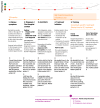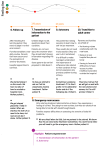Mapping the Patient Experience in a Pediatric Hemophilia Unit: Our Patient Journey
- PMID: 39458185
- PMCID: PMC11508278
- DOI: 10.3390/jcm13206235
Mapping the Patient Experience in a Pediatric Hemophilia Unit: Our Patient Journey
Abstract
Background: Hemophilia is a rare X-linked bleeding disorder. Prophylaxis has improved outcomes, but there are still unmet needs to be addressed. The aim of this study was to develop a patient journey in pediatric patients with hemophilia, a visual tool that illustrates patients' relationship with the healthcare provider through time useful for identifying patient needs, potential concerns ("pain points"), and gaps in care. Methods: qualitative study in a pediatric hemophilia unit using a human-centered design methodology. First stage: discover and empathize: (a) semi-structured interviews to patients/families and stakeholders; (b) observation techniques ("shadowing") to patients/families and professionals. Second stage: analyzing the collected information to create the patient journey. Results: A preliminary "clinical journey" was built using information from eight interviews with professionals from the interdisciplinary hemophilia team. Interviews with patient association representatives, 13 patients/families, and six "shadowing" techniques with patients and professionals were used to compare the "clinical journey" with the patient's reported experience. Main "pain points" were detected before diagnosis, at diagnosis, during assimilation, at treatment initiation, during training, and when patients start asking about their condition. The empowerment process was detected as a potential moment to improve patient/family experiences. Conclusions: The patient journey helps to better understand patient/family experiences related to the disease in different scenarios. Caregivers and patient learning and empowerment processes are significant moments where the interdisciplinary team should focus to offer valuable solutions to improve outcomes. Further research is required in this area, particularly empirical research to amend or confirm the suggested patient journey.
Keywords: children; hemophilia; human-centered design; patient experience; patient journey.
Conflict of interest statement
The authors declare the following financial interests/personal relationships that may be considered as potential competing interests: Rubén Berrueco reports consultancy/honoraria, speaker fees, and travel/accommodations from Bayer, CSL-Behring, Novartis, Boehringer-Ingelheim, Sobi, Novo-Nordisk, Takeda, Pfizer, and Roche. Nuria Caballero and Cristina Benedicto report speaker fees and travel/accommodations from Sobi and Roche. Natalia Rodríguez-Nieva reports speaker fees and travel/accommodations from Sobi. The rest of the authors have no relevant financial or non-financial interest to disclose.
Figures



References
-
- Klamroth R., Pollmann H., Hermans C., Faradji A., Yarlas A.S., Epstein J.D., Ewenstein B.M. The Relative Burden of Haemophilia A and the Impact of Target Joint Development on Health-Related Quality of Life: Results from the ADVATE Post-Authorization Safety Surveillance (PASS) Study. Haemophilia. 2011;17:412–421. doi: 10.1111/j.1365-2516.2010.02435.x. - DOI - PubMed
-
- Manco-Johnson M.J., Kempton C.L., Reding M.T., Lissitchkov T., Goranov S., Gercheva L., Rusen L., Ghinea M., Uscatescu V., Rescia V., et al. Randomized, Controlled, Parallel-Group Trial of Routine Prophylaxis vs. on-Demand Treatment with Sucrose-Formulated Recombinant Factor VIII in Adults with Severe Hemophilia A (SPINART) J. Thromb. Haemost. 2013;11:1119–1127. doi: 10.1111/jth.12202. - DOI - PubMed
Grants and funding
LinkOut - more resources
Full Text Sources

